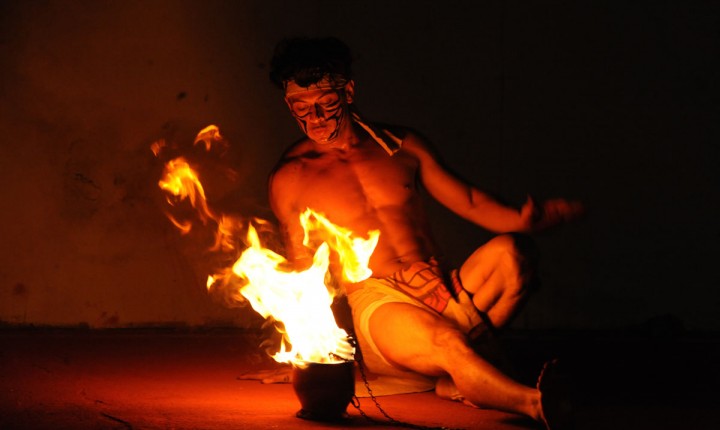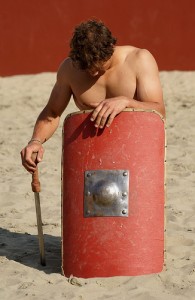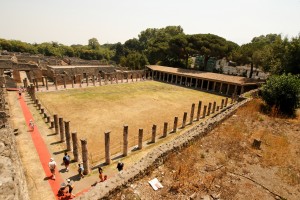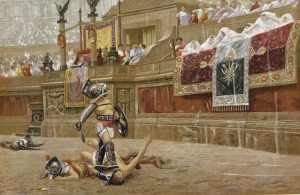“I will endure to be burned, to be bound, to be beaten, and to be killed by the sword”
Sacramentum Gladiatorium (The Gladiators’ Oath)
This was the oath that every novicius (new recruit) took on his way to becoming a gladiator, when he first entered the ludus (gladiator school). He essentially surrendered his life to his lanista (owner/trainer) who would then transform him into an efficient and skillful warrior. Whether he entered the ludus as a slave captured in battle, a criminal sentenced to imprisonment, a volunteer or a private citizen, he was exposed to the same rigorous training, partook of the same diet, and endured the same living conditions. Though times may have been harsh, the gladiator was not mistreated as he was viewed as an investment and could make a great deal of money for his lanista as well as put away a tidy sum for himself. His role in society would be one of duality: He would be scorned for his status as a slave yet beholden as a hero for his prowess in the ludi (games). His future was grim, as the future of a gladiator offers few options. Death was certain for many, but a mighty few would conquer on to receive the rudis, the wooden sword that represented a gladiator’s freedom.
As a novicius, the very first thing the young gladiators were required to do is get a complete physical examination to determine if they met the physical requirements necessary to be a gladiator. If not, those who were rejected often went on to meet a fate of tedious physical labor. They were then separated by the style of fighting they were going to train in. They were segregated in this fashion so that they would not meet their future opponents. It is believed that the different fighting styles were derived from the different styles of combat the Romans encountered while engaged in war. The varied fighting techniques were given the name of the conquered people: Eques (horseman), Hoplomachus (heavy-weapons fighter), Murmillo (fish), Provacator (attacker), Retiarius (net man), Secutor (pursuer), and Thraex (Thracian).
Training was brutal and designed to get you in top physical condition. Gladiators trained with their familia gladiatorium, a troupe of fighters living together and training under the same style, but also trained in the defense of the styles they would be confronted with. They learned to use the various size shields and how to move quickly and with agility to compensate for a heavy sword. The gladiators endured their training and were fastidious in their regimen, as they were well aware that it was their acquired skills that would aid in the fight for their lives.
Sources seem to agree that gladiators were fed a high-energy vegetarian diet. As Andrew Curry informed us in his article “The Gladiator Diet,” the gladiator consumed a lot of simple carbohydrates such as barley and beans. This was done so that the gladiator could cushion his body with a protective layer of fat covering nerves and keeping flesh wounds from becoming mortal wounds. To compensate for the lack of calcium this diet left, they drank brews of charred wood or bone ash, which are rich in calcium. The gladiator had to be diligent even in his diet, as it strategically fit into his training for survival.
 Gladiators were kept in barracks where they lived and trained. Within these barracks, the individual gladiators were kept in cells and were usually confined in shackles. The gladiators seldom left their cells. When they did, it was for training or eating one of their three meals a day in the hall. The remainder of the time he was left to contemplate his thoughts, bound and in solitude.
Gladiators were kept in barracks where they lived and trained. Within these barracks, the individual gladiators were kept in cells and were usually confined in shackles. The gladiators seldom left their cells. When they did, it was for training or eating one of their three meals a day in the hall. The remainder of the time he was left to contemplate his thoughts, bound and in solitude.
Though conditions were not generous, the gladiator was not abused. This is because the gladiator was his lanista’s source of income. At the ludi, a lanista could make a great deal of money with a good team of gladiators. The gladiator, in turn—if he had a good following and or had fought well—would receive money from the spectators. Emperors who were thrilled by the ludi would bestow large sums of money and jewels to a favored gladiator. A gladiator who was not adequately trained or properly fed would only serve to empty a lanista’s coffers. It obviously was in the lanista’s interest to maintain the health and ability of his gladiators. Just as sports teams today provide their players with great trainers, excellent medical attention, and massage therapy, the gladiators of old were taken care of in the same manner.
As a slave, the gladiator held the lowest station in life one could in ancient Rome. For this status he was scorned and looked down upon. In stark contrast, when he put on his gladiatorial armor and helmet, took up his sword, and shield and planted his feet firmly into the sands of the arena, the gladiator was transformed into an ethereal being, a barbarian warrior bent on destruction and thirsting for blood, giving the frenzied throngs the spectacle they intended to see. The crowds loved to see it!
While we are trained to believe that all contests between gladiators ended in bloodshed, it was the exceptionally skilled fighter who could win without hurting his opponent who had a strong following. A gladiator could also claim defeat and ask for the missio, for his life to be spared. It was customary for him to receive this pardon, as the lanista was compensated for gladiators lost in the ludi by the editor (the sponsor of the ludi).
The Roman spectators followed gladiators as we would follow the career of a football or baseball player. Roman girls were no different and the effect of the gladiator was not lost on some as they were said to swoon at the sight of two combatants engaged in contest. It has been noted that the appeal of the gladiator was so strong that one Roman Senator’s wife ran away with one.
Even the novicius gladiator knew that an early death was a large reality of his future. A part of his training was the preparation of dying with dignity. He knew that a “glorious death” would remove the mark of disgrace from upon him. To disgrace himself in death would lead to his dead body thrown and discarded outside of the city limits. The life span of a gladiator was relatively short, with the average gladiator not living past the age of thirty. If a gladiator was skillful enough and fought well, in time, he could gain his freedom. He was then presented with a rudis. To attain this, a gladiator typically had to be involved in thirty contests or serve five years to his lanista. This discharged him from his oath. He could then become a lanista or hire his services out as a bodyguard.
This has been but only a glimpse into the life of an ancient gladiator. A basic understanding has been provided; future articles will expound further on the various aspects of that ancient parallel and how it is relevant to our modern lives. We invite you to follow us as we continue to unfold and reveal the daily rigors of the lowly but exalted gladiator, from the way he lived to his death.
Photo Credit: <a href=”http://www.flickr.com/photos/46837917@N00/1805154543/”>Jolanda van Tuijl</a> via <a href=”http://compfight.com”>Compfight</a> <a href=”http://www.flickr.com/help/general/#147″>cc</a>
Photo Credit: <a href=”http://www.flickr.com/photos/10687839@N03/2449886074/”>Manel Segarra</a> via <a href=”http://compfight.com”>Compfight</a> <a href=”http://www.flickr.com/help/general/#147″>cc</a>
Related Posts
One Response to I Will Endure to be Burned
Leave a Reply
You must be logged in to post a comment.
« The ART of Being Single Feeling The Stress of Life and Needing Relief? »















luottoa
Stella